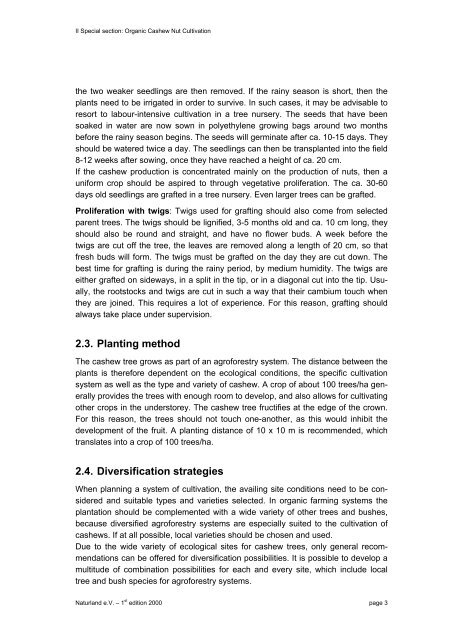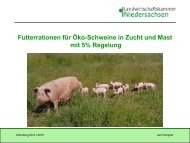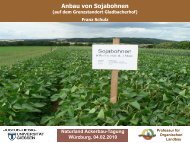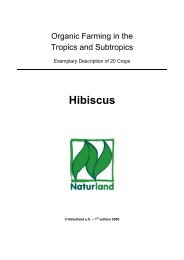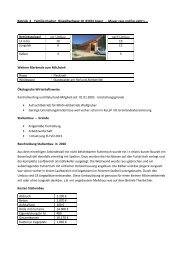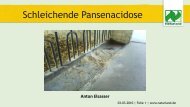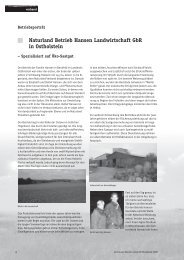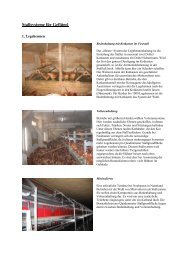Cashew Nuts - Naturland
Cashew Nuts - Naturland
Cashew Nuts - Naturland
You also want an ePaper? Increase the reach of your titles
YUMPU automatically turns print PDFs into web optimized ePapers that Google loves.
II Special section: Organic <strong>Cashew</strong> Nut Cultivation<br />
the two weaker seedlings are then removed. If the rainy season is short, then the<br />
plants need to be irrigated in order to survive. In such cases, it may be advisable to<br />
resort to labour-intensive cultivation in a tree nursery. The seeds that have been<br />
soaked in water are now sown in polyethylene growing bags around two months<br />
before the rainy season begins. The seeds will germinate after ca. 10-15 days. They<br />
should be watered twice a day. The seedlings can then be transplanted into the field<br />
8-12 weeks after sowing, once they have reached a height of ca. 20 cm.<br />
If the cashew production is concentrated mainly on the production of nuts, then a<br />
uniform crop should be aspired to through vegetative proliferation. The ca. 30-60<br />
days old seedlings are grafted in a tree nursery. Even larger trees can be grafted.<br />
Proliferation with twigs: Twigs used for grafting should also come from selected<br />
parent trees. The twigs should be lignified, 3-5 months old and ca. 10 cm long, they<br />
should also be round and straight, and have no flower buds. A week before the<br />
twigs are cut off the tree, the leaves are removed along a length of 20 cm, so that<br />
fresh buds will form. The twigs must be grafted on the day they are cut down. The<br />
best time for grafting is during the rainy period, by medium humidity. The twigs are<br />
either grafted on sideways, in a split in the tip, or in a diagonal cut into the tip. Usually,<br />
the rootstocks and twigs are cut in such a way that their cambium touch when<br />
they are joined. This requires a lot of experience. For this reason, grafting should<br />
always take place under supervision.<br />
2.3. Planting method<br />
The cashew tree grows as part of an agroforestry system. The distance between the<br />
plants is therefore dependent on the ecological conditions, the specific cultivation<br />
system as well as the type and variety of cashew. A crop of about 100 trees/ha generally<br />
provides the trees with enough room to develop, and also allows for cultivating<br />
other crops in the understorey. The cashew tree fructifies at the edge of the crown.<br />
For this reason, the trees should not touch one-another, as this would inhibit the<br />
development of the fruit. A planting distance of 10 x 10 m is recommended, which<br />
translates into a crop of 100 trees/ha.<br />
2.4. Diversification strategies<br />
When planning a system of cultivation, the availing site conditions need to be considered<br />
and suitable types and varieties selected. In organic farming systems the<br />
plantation should be complemented with a wide variety of other trees and bushes,<br />
because diversified agroforestry systems are especially suited to the cultivation of<br />
cashews. If at all possible, local varieties should be chosen and used.<br />
Due to the wide variety of ecological sites for cashew trees, only general recommendations<br />
can be offered for diversification possibilities. It is possible to develop a<br />
multitude of combination possibilities for each and every site, which include local<br />
tree and bush species for agroforestry systems.<br />
<strong>Naturland</strong> e.V. – 1 st edition 2000 page 3


